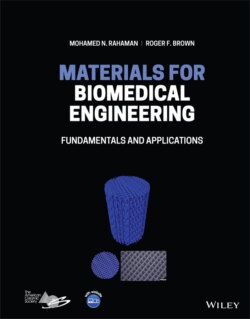Читать книгу Materials for Biomedical Engineering - Mohamed N. Rahaman - Страница 121
Elastic and Plastic Deformation
ОглавлениеThe measured stress–strain curves of solids show a variety of shapes but the schematic curve in Figure 4.2 can be used to illustrate the distinction between elastic and plastic deformation. For metals, perfectly elastic behavior (less than approximately 0.1% strain) is followed by plastic deformation that can continue to much larger strains until the specimen fails, typically by breaking into two pieces. The strain at which the specimen fails, called the elongation to failure, can be in the range ~1% to over 50% for many metals. In comparison, ceramics fail within their elastic region, at strains less than ~0.1%, and the material fractures catastrophically into two or more pieces, a failure mode called brittle fracture. The ability to deform plastically is commonly referred to as ductility and, thus, metals are said to be ductile whereas ceramics are brittle.
Figure 4.2 Schematic stress–strain curve to illustrate the distinction between elastic and plastic deformation of materials.
A key difference between elastic deformation and plastic deformation is that unlike elastic deformation, the strain or elongation due to plastic deformation is not recovered upon unloading the material. Upon loading a specimen from its unloaded dimension (point O in Figure 4.2) to point A in the elastic region, the specimen returns to its original dimension along the same line AO. Upon loading, atoms in the solid are displaced slightly from their equilibrium sites but do not take up new sites (Chapter 2). When the load is removed, the atoms return to their original equilibrium sites. In comparison, plastic deformation is irreversible. Upon loading a specimen to point B, the specimen follows the line BO′ upon unloading which is approximately parallel to AO. The small elastic portion of the strain is recovered but not the plastic portion. The atoms take up new sites relative to each other by movement of dislocations (Chapter 3). To summarize at this stage, the key features of elastic and plastic deformation are:
Elastic deformationStrains commonly smallReversible: the material returns to its original unloaded dimensionAtoms are displaced slightly upon deformation but do not take up new sites
Plastic deformationStains much larger than elastic deformationIrreversible: the plastic strain is not recovered upon unloadingAtoms take up new sites relative to each other
